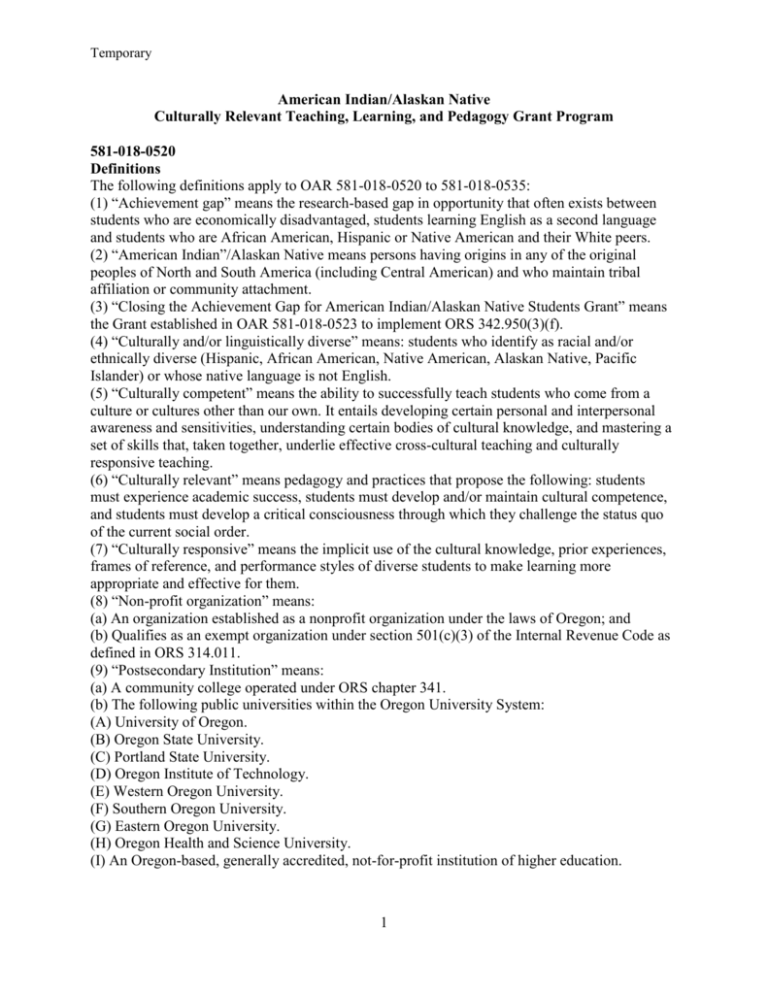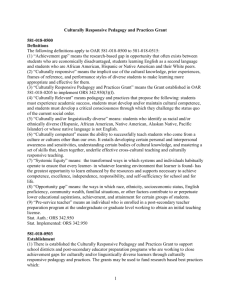American Indian/Alaskan Native Culturally Relevant Teaching
advertisement

Temporary American Indian/Alaskan Native Culturally Relevant Teaching, Learning, and Pedagogy Grant Program 581-018-0520 Definitions The following definitions apply to OAR 581-018-0520 to 581-018-0535: (1) “Achievement gap” means the research-based gap in opportunity that often exists between students who are economically disadvantaged, students learning English as a second language and students who are African American, Hispanic or Native American and their White peers. (2) “American Indian”/Alaskan Native means persons having origins in any of the original peoples of North and South America (including Central American) and who maintain tribal affiliation or community attachment. (3) “Closing the Achievement Gap for American Indian/Alaskan Native Students Grant” means the Grant established in OAR 581-018-0523 to implement ORS 342.950(3)(f). (4) “Culturally and/or linguistically diverse” means: students who identify as racial and/or ethnically diverse (Hispanic, African American, Native American, Alaskan Native, Pacific Islander) or whose native language is not English. (5) “Culturally competent” means the ability to successfully teach students who come from a culture or cultures other than our own. It entails developing certain personal and interpersonal awareness and sensitivities, understanding certain bodies of cultural knowledge, and mastering a set of skills that, taken together, underlie effective cross-cultural teaching and culturally responsive teaching. (6) “Culturally relevant” means pedagogy and practices that propose the following: students must experience academic success, students must develop and/or maintain cultural competence, and students must develop a critical consciousness through which they challenge the status quo of the current social order. (7) “Culturally responsive” means the implicit use of the cultural knowledge, prior experiences, frames of reference, and performance styles of diverse students to make learning more appropriate and effective for them. (8) “Non-profit organization” means: (a) An organization established as a nonprofit organization under the laws of Oregon; and (b) Qualifies as an exempt organization under section 501(c)(3) of the Internal Revenue Code as defined in ORS 314.011. (9) “Postsecondary Institution” means: (a) A community college operated under ORS chapter 341. (b) The following public universities within the Oregon University System: (A) University of Oregon. (B) Oregon State University. (C) Portland State University. (D) Oregon Institute of Technology. (E) Western Oregon University. (F) Southern Oregon University. (G) Eastern Oregon University. (H) Oregon Health and Science University. (I) An Oregon-based, generally accredited, not-for-profit institution of higher education. 1 Temporary (10) “Systemic Equity” means the transformed ways in which systems and individuals habitually operate to ensure that every learner--in whatever learning environment that learner is found--has the greatest opportunity to learn enhanced by the resources and supports necessary to achieve competence, excellence, independence, responsibility, and self-sufficiency for school and for life. (11) “Title VII Indian Education” means a federally funded program receiving United State Department of Education Title VII – Indian, Native Hawaiian, and Alaska Native Education funding. (12) “Tribe” means: (a) The Confederated Tribes of the Warm Springs Indian Reservation. (b) The Confederated Tribes of the Umatilla Indian Reservation. (c) The Burns-Paiute Tribe. (d) The Confederated Tribes of Siletz Indians of Oregon. (e) The Confederated Tribes of the Grand Ronde. (f) The Cow Creek Band of Umpqua Indians. (g) The Confederated Coos, Lower Umpqua and Siuslaw Tribes. (h) The Klamath Tribe. (i) The Coquille Tribe. Stat. Auth.: ORS 342.950 Stat. Implemented: ORS 342.950 581-018-0523 Establishment (1) There is established the American Indian/Alaskan Native Culturally Relevant Teaching, Learning, and Pedagogy Grant Program to support the collaborative efforts to design, implement, improve, expand or otherwise infuse American Indian/Alaskan Native culturally responsive pedagogy and effective instructional practices to increase student academic achievement, high school completion and successful engagement in post-secondary educational opportunities. (2) Subject to available funds, the grant will be awarded for the biennium based on a detailed description of proposed programming or services. (3) The purpose of the grant program is to provide funds for programs that have the potential to become exemplar programs and can create collaborative practices through the facilitation of: (a) Strengthening relationships between school district, local community and tribal governance; (b) Collaboration between school districts, non-profit organizations, Title VII Indian Education Programs, postsecondary institutions, native communities or organizations, and education service districts to assist with identifying evidence-based practices and best practices; (c) Enhancing the American Indian/Alaskan Native cultural competence of district educators; (d) Developing and implementing best practices in an effort of increasing academic outcomes of American Indian/Alaskan Native; and (e) Developing or expanding opportunities to include American Indian/Alaskan Native language and culture in classrooms. Stat. Auth.: ORS 342.950 Stat. Implemented: ORS 342.950 2 Temporary 581-018-0526 Eligibility (1) To be eligible to receive the American Indian/Alaskan Native Culturally Relevant Teaching, Learning, and Pedagogy Grant Program a qualified applicant must: (a) Be a school district or consortia of districts and must have a partnership with one or more of Oregon’s federally recognized Tribes; or (b) Be a non-profit organization focusing on Indian education applying in collaboration with a school district. (2) Qualified applicants must also be available to work with a consultant, provided by Oregon Department of Education, to receive guidance and support during all phases of the funding cycle. (3) A single grant proposal may include more than one eligible proposal and other entities but the lead agency for the proposal must be a school district or a non-profit organization. (4) The Department of Education shall give preference to applicants that meet the minimum qualifications described in this section and who can demonstrate collaborative relationships with partners with expertise in working with American Indian/Alaskan Native students or educators who provide educational services to American Indian/Alaskan Native students. The partners may include but are not limited to postsecondary institutions, education service districts, federal Title VII Indian Education programs and native communities or organizations. Stat. Auth.: ORS 342.950 Stat. Implemented: ORS 342.950 581-018-0529 Criteria (1) The Oregon Department of Education shall establish a request for proposal solicitation and approval process to be conducted for the American Indian/Alaskan Native Culturally Relevant Teaching, Learning, and Pedagogy Grant Program funds. All proposals must comply with the requirements of ORS 342.950 and rules adopted to implement that section. (2) Grants shall be awarded based on the following criteria: (a) Whether the grant application identifies how the funds will be used to reach the 40-40-20 goal and improve education outcomes for American Indian/Alaskan Native students as identified by the Oregon Education Investment Board Equity Lens document; (b) Whether the grant application describes a strong and robust plan to close achievement gaps for American Indian/Alaskan Native students; (c) Whether the grant application describes expected outcomes and a strong and robust plan to achieve those outcomes; and (d) Whether the grant applications demonstrates how partners will collaborate on a mutually designed proposal in which all essential parties participate. (3) The Department shall give priority to proposals that meet the minimum criteria and that demonstrate the use of evidence-based or best practice models of the required elements specific to American Indian/Alaskan Native: (a) Culturally Responsive Pedagogy: (A) Communication of high expectations. (B) Teacher as facilitator within classroom. (C) Integration of students’ prior knowledge and skills through cultural activities, language, ways of life, the arts, and traditional knowledge system. 3 Temporary (D) Positive perspectives on parents and families of culturally and linguistically diverse students. (E) Cultural sensitivity. (F) Curricular decisions. (G) Culturally mediated instruction. (H) Student-centered, student-controlled classroom discourse. (b) Culturally Responsive Leadership: (A) Commitment to reform the educational system to reflect culturally responsiveness through organization of the school and school policies and procedures. (B) Reshaping the curriculum. (C) Professional development that is grounded in the principles of culturally responsive teaching. (c) Culturally Responsive Community Engagement: (A) Collaboration with one or more of the Tribes in Oregon or Title VII Indian Education Program. (B) Postsecondary institution. (C) Education Service Districts. (D) Local American Indian/Alaskan Native communities and organizations. (E) Community involvement of stakeholders (families, advocacy organizations, and other private, non-profit, business, faith-based organizations). (F) Communication with families that is regular, uses diverse media and shares student achievement status and goals. (d) Culturally Responsive Pre-Service and In-Service for Teachers: (A) Coursework and field experiences for pre-service teachers that focuses on culturally responsive teaching, learning, and practice that: (i) Reflects relevant research; (ii) Uses local data; (iii) Ensures principles of culturally responsive pedagogy. (B) Includes collaboration with institutes of higher education (specifically Oregon Native American Indian Education Teacher Programs). (e) Provide a sustainability plan to continue the program for at least two years after the grant funding has ended. (f) The extent to which the proposal clearly documents its capacity to implement and carry out programming and services for American Indian/Alaskan Native culturally responsive pedagogy, practices, and professional development and demonstrates intentions to work in a collaboration with identified partners. Stat. Auth.: ORS 342.950 Stat. Implemented: ORS 342.950 581-018-0532 Funding (1) The Department may award grants up to $100,000 based on a detailed budget narrative and budget template. (2) Grantees shall use funds received for the grant for activities outlined in the request for proposal. (3) Grantees must be able to expend the funds for allowable purposes specified in the request for proposal within the grant timeline according to acceptable accounting procedures. 4 Temporary Stat. Auth.: ORS 342.950 Stat. Implemented: ORS 342.950 581-018-0535 Reporting The Oregon Department of Education shall provide to grant recipients a template for an interim and final grant report. Grantees are required to submit a final report prior to receiving their final request for funds. Stat. Auth.: ORS 342.950 Stat. Implemented: ORS 342.950 5






